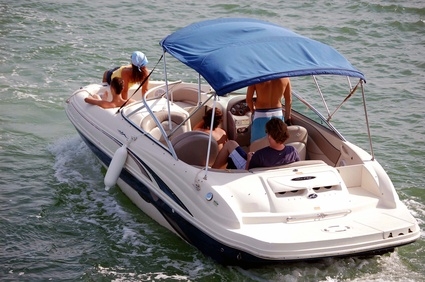
The power steering pump on a marine engine performs the same function as it does on an automobile: It uses hydraulic pressure to increase the turning strength of the rudder or prop in the water. Power steering pumps can fail due to dry or cracked fluid reservoirs, bad shaft bearings or defective high-pressure lines. Sometimes the power steering pump pulley fails by bending, cracking or spinning on the pump shaft due to a worn key-way. Replacing or repairing the Mercruiser power steering pump pulley can be performed by the do-it-yourself boat repair person, using a few simple steps and tools.
Remove the cowl casing from your Mercruiser engine by unclasping the hold-down clips. Lift the cowl up and set it aside. Disconnect the negative battery cable with a socket. Spray penetrating oil on the front shaft bolt of the power steering pump pulley and let it soak.
Look at your belt arrangement; you with have either a single belt that joins the crankshaft, alternator and powers steering pump, or a serpentine belt. For the single belt motor, use a socket and wrench to loosen the bottom bracket bolt on the alternator.
Loosen the alternator adjustment bolt on the upper bracket. Use a pry bar to wedge the alternator casing inward to relieve the belt pressure. Slip the alternator belt off. For the serpentine belt configuration, place a socket and wrench on the center bolt of the tensioner pulley.Turn the wrench to relieve the pre-load pressure and slip the belt off the pulley. Remember the routing configuration of the serpentine belt, or refer to your boat owner's manual for the proper placement.
Place a large screwdriver though the vent holes of the pulley and wedge the pulley still. Use a socket and wrench to remove the large pulley bolt. Use penetrating oil liberally. If the bolt refuses to come off, use an air ratchet wrench and socket to shock it loose.
Spray more penetrating oil on the pulley shaft. Place power steering pump puller clamps around the backside of the pulley. Place the threaded shaft of the puller on the shaft end, inside the recessed hole.Twist the T-handle of the puller tool until the pulley begins to slide along the shaft. Remove the pulley completely from the shaft.
Sand the power steering pump shaft with 400-grit sandpaper, removing the rust and burs. Wipe the shaft with carburetor cleaner and a rag. Place a new key on the pump shaft, then wipe the shaft with some clean oil. Slide the new pulley on the shaft toward the engine. Use a hammer to tap the pulley until it sits flush with the back seat against the pump.
Wedge the pulley with a screwdriver and replace the pulley bolt. Tighten the bolt with a socket and wrench. Remove the screwdriver. Slip the alternator belt back over the power steering pump pulley and wedge the alternator against the belt pressure with a pry bar. You need 1/4-inch slack in the belt. Tighten the top alternator bracket bolt and the bottom mount bolt with a socket and wrench.
Place the socket and wrench on the tensioner pulley bolt and turn the handle to compress the tensioner (for the serpentine belt version). Slip the serpentine belt back on the power steering pump pulley. Relieve the pressure on the wrench to load the pressure tension. Reconnect the negative battery cable with a socket. Replace the engine cowl and snap it in place.